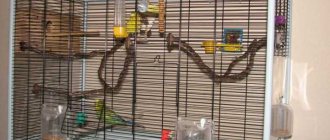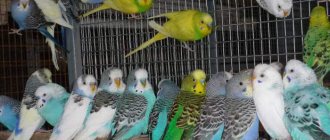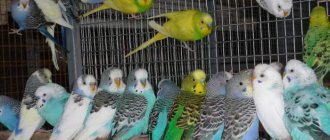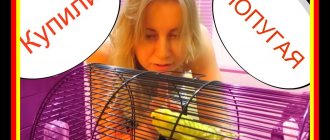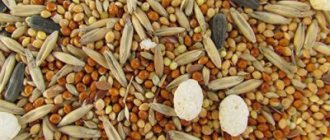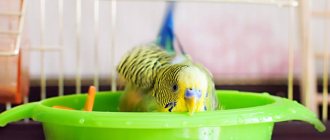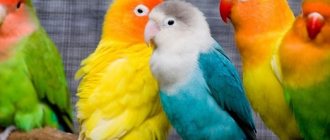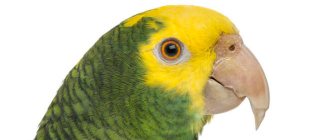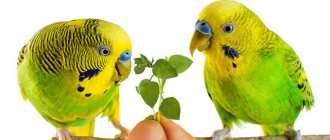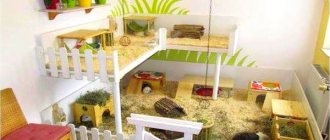How many parrots to buy
The number of birds depends on the goals and capabilities of the breeder.
If you are choosing a companion who will brighten up your loneliness, it is better to take one talking parrot. Constant communication and care will allow the new pet to become a full member of the family over time. Connoisseurs of silence are advised to get a girl budgerigar, since females are less noisy than males. If the owners are not home much, the lonely bird begins to feel sad. You can save your feathered ward from sadness by choosing company for him. Two or three individuals can live in one spacious cage. Well, if you have plans for breeding, buy a female and a male at once.
Selection rules
Many people think that the bird suffers alone because it lacks communication. But if the parrot is given a lot of attention, then it feels great and also quickly learns to speak. If the parrot remains alone throughout the day, then it is advisable to find a mate for it.
It is advisable to initially buy budgies in pairs, and also choose a mate for the bird after it learns to speak.
In order to choose the right pair for a male or female budgie, you need to take into account the following factors:
if you plan to breed birds in the future, then it is advisable to choose parrots with the same color;- the male must be older than the female, and the difference must be from 2 to 4 years, otherwise the female will dominate;
- It is recommended to choose a large male, otherwise the female may peck him during the mating season;
- before purchasing, the bird’s temperament is assessed, since its character must match the existing parrot;
- At the time of acquaintance, it is desirable that the male is sexually mature and the female is about 4 months old, since an adult bird can show aggression and dominate.
During the adaptation period, it is important to create a calm atmosphere, and a spacious cage with a house is also purchased.
If you purchase birds with different colors, this often leads to the appearance of sick offspring. It is forbidden to mate closely related parrots, as the resulting chicks are underdeveloped.
How many parrots do you have?
12
How to teach to talk
It is clear that if you do not work with the wavy, he himself will never learn to imitate human speech. You need to learn conversation from an early age, but not immediately after purchase. Be sure to give the bird time to adapt. Depending on the nature of the bird, this could be a week, two or even three. In any case, there is no need to rush.
You need to start teaching your parrot words only after he gets used to you - he will not run deeper into the cage when you approach, he will boldly sit on your finger, take food from your hands, etc. Initially, you need to teach the simplest and shortest words that need to be repeated regularly when performing some action. For example, when pouring food, you can say “Eat”, changing the water - “Water” or “Drink”, etc. If you want to teach your parrot long phrases, record them on a voice recorder and play them back to your parrot.
It is important that it is better to do this in the twilight, because if the bird sees poorly, they begin to concentrate on sounds. It has been noticed that budgies perceive high-pitched voices better, for example, women's voices.
Now you know how to choose a parrot for your home so that it can start talking. It's not as difficult as it might seem at first glance.
Purpose
Determining the sex of a budgie is important for several reasons. First of all, this affects the choice of a pet’s name, because birds most often remember their nickname and respond to it. Having learned after a couple of years that “Kesha” may turn out to be a girl, many may be very surprised or even upset.
In addition, the owner of the parrots may decide to breed chicks. In this case, you can also make a mistake in choosing a pair for your pet. After all, birds of the same sex can have great conflicts with each other. And in the future, a task of this kind will require the owner to have the skills to determine the sex of birds.
Based on the above words about parrot conflict, it is important to note that males can make great friends and live in the same cage without any problems. Unlike females, whose cohabitation in most cases leads to a complex conflict, to the point that one of them can easily die, for many this can be a heavy loss.
To a greater extent, the gender of a budgerigar affects the ability to repeat sounds. Most birds of this species are able to master speech to one degree or another. However, the speed and difficulty of learning to speak will vary between birds of different sexes - as a rule, males are much easier to teach the pronunciation of words. But at the same time, although females require more attention and dedication in training, they master conversation better than males, and can remember a slightly larger number of words, which they can pronounce more clearly.
An important criterion when choosing a pet is its character. It can play a significant role in taming a parrot. Thus, females are more aggressive and timid. Therefore, some of them may never get used to the hands and rush around the cage every time they see its door opening. In contrast, males are more positive, more willing to be handled, and moreover, they like to spend time near people.
In addition, depending on the time of year, the character of females can vary greatly. Behind the changes, as a rule, there are surges of hormones in the spring or autumn. This can make even the calmest female hostile and aggressive.
This information is already enough to decide what gender of bird you would like to purchase. However, a parrot of any gender can bring a lot of positive emotions; the only difference will be in the approach to education.
Let's look at how to determine the gender of a budgie. There are several methods that focus on some pronounced or not very pronounced features.
Source
Habits and character of the male, in contrast to the female
Observing pets at home, you can notice behavior patterns that directly or indirectly indicate the sex of the birds. How can you tell a boy's parrot from a girl's parrot if you look closely at their habits?
The male is nimble, restless, talkative. If you hang a mirror in a cage, the boy will show off in front of his reflection and try to bully his imaginary opponent. Even the songs of budgerigars are different: in the male they are loud, complex, and drawn-out. During his walk, he flies a lot and explores every corner with interest. Emphasizes its dominant position, puts its paw on its cage neighbor. The boy parrot is more successful in mastering human speech; his onomatopoeia is better developed.
The female with a wavy pattern can be distinguished by her modest manners; she is quiet and economical - she likes to clean up the cage. She chirps more than sings, her voice is expressionless. There is almost no ability to learn, the cases of pronouncing words are very rare. In communication with a person he does not show initiative, but in his hands he behaves quietly. The released bird, after flying for a bit, takes an observation position.
Shyness and submissiveness do not guarantee that you will accurately know the gender of a parrot. Not all females have a balanced character. There are individuals that are distinguished by jealousy and aggression. They constantly quarrel with their neighbors, mostly female.
Other methods of determining gender
There are several other methods by which you can find out the gender of a wavy.
Genetic method
In some cases, it is possible to determine the sex of a chick even before fledging. The method is based on taking into account certain features in the phenotype of chicks. The fact is that the gene of many mutations is directly related to gender. Therefore, in some cases it is possible to name the sex of a chick accurately. It has been experimentally established that if:
By behavior
More experienced parrot lovers can accurately determine the male and female budgerigar based on the behavior of a particular bird. The method is based on taking into account the behavioral characteristics of the sexes. Males differ:
The character of females is more complex. They are very curious and observant. They love cleanliness very much. If a bird often tidies up its cage, this most likely means that it is female. At the same time, females:
There are certain behavioral signs in the intimate sphere as well. During sexual intercourse or its imitation, the male almost always ends up on top. The representative of the stronger sex often places his foot on the girl or on any suitable object.
Using a DNA test
The only method that can guarantee results with 99.9% accuracy. Its algorithm is as follows:
This method has the following advantages:
The disadvantages of this technique are also very significant. These include:
Determining the sex of budgerigars is a rather difficult, but very interesting task. To solve it correctly on your own, the bird owner must:
Source
How to determine the sex of rosella, necklace, and gray parrots
Parrots of the genus Gray, Rosella and necklace representatives are also chosen for home keeping. These birds have characteristic appearance features that can be used to determine their gender.
The main differences between females and males:
- By the age of 2-3 years, male parrots with necklaces develop a black rim around their necks, resembling a necklace. Girls do not have such decoration.
- Male African Gray parrots have a large body, a small flat head and a short neck. Girls are slimmer, have a rounded head, and a long neck. Males have a more uniform and darker color. Females have gray belly feathers.
- Boys of the genus Rosella have a sloping nape and a massive beak at the base. Females have a round head and light stripes on the inside of their wings.
The most accurate answer to determining the sex of a parrot will be shown by a DNA test. The study is carried out in laboratory conditions. The owner must provide a plucked feather for analysis (feathers that fall out are not suitable for testing). Such an analysis is quite expensive, but it shows a 100% reliable result.
Regardless of gender, parrots in the house need to be provided with comfortable conditions and a healthy diet for health and longevity. In our store you can buy high-quality food for different types of parrots, healthy supplements with vitamin and mineral complexes, cozy cages for birds to live in, feeders, drinkers, perches, various toys and other accessories for a comfortable and healthy life for your feathered friend!
Genetic diagnosis of sex
One of the most reliable ways to distinguish between female and male budgerigars is genetic research. This method of sex determination is based on the study of the properties inherent in the bird: the number of chromosomes in males and females differs. This only works in a few varieties resulting from gene mutation:
The chromosome set is checked in the laboratory, but even at home, you can sometimes distinguish a boy from a girl parrot by the color of its feathers. To do this, the chick must grow feathers. In this case, it is necessary to see a couple of breeding birds, that is, this method is suitable for breeders.
How to determine the sex of a parrot based on the color of the parents:
The sex of a parrot is determined by the shape of its head and the color of its legs. Boys' paws are blue, and their heads are large and have a flattened crown. Girls have pink fingers, a pointed forehead and a flat nape.
Choice of talking wavy
If you're wondering how to choose a talking budgie, here are our top tips.
- The easiest thing is not to buy a talking parrot, but to teach it to speak on its own. Therefore, the question should rather be how to choose a budgerigar so that it speaks.
- You need to start training your parrot as early as possible; green males, according to statistics, learn human speech skills easier and faster. White birds, on the contrary, are least likely to have such abilities.
- There is an opinion that you need to choose the weakest chick in the brood, go out and tame it. It is such a bird that will recognize its owner as its leader and will begin to obey him.
- The most optimal age when a bird is able to start talking is about 7-8 months. It is better to start learning with words with hissing sounds.
Thus, to the question of how to choose a budgerigar to speak, the answer is this: you need to choose a young male parrot, while all the signs of an active, healthy bird should not raise even a shadow of doubt.
How to distinguish from a photo
Parrot sellers insist on keeping track of the differences between a boy and a girl using photographs. After viewing a certain number of photos, you can catch certain patterns in the behavior, reaction and color of the birds.
Do you have a parrot?
Not really
Cheek spots
If you look closely at the pets' cheeks, you can discern a faint color. Females have light purple tones, while males have dark purple tones. Depending on the color of the plumage, these spots are visible a little better or worse, so this method cannot boast of accuracy.
How to distinguish a female from a male by wax
To find out whether a budgie is a girl or a boy, find the wax itself. In a parrot, this is a soft, smooth place that protrudes slightly just above the beak. The two holes are the nostrils through which the pet breathes. The beak is usually yellow, but the cere of females and males is different.
Chicks
Determining the sex of chicks is quite difficult, because... The color scheme of the skin above the beak can change during the day, which means you need to conduct several studies over 3-4 days or take photographs for clarity. It is possible to reliably determine the sex of a chick only after the 3rd week of its life.
Female:
- main shades: bluish, light purple, all varieties of pink;
- the skin over the beak has an uneven color, there are light circles around the nostrils;
- if the beak is still purple, and this is possible with both females and males, then the female's cere will have blue tones;
- the pink tint of the cere can be a sign of both a boy and a girl, but in this case it is worth focusing on the uniform distribution of color and the type of peri-nostril circles.
Male:
- Lilac, violet and pink shades dominate
- The color, unlike females, is evenly distributed and uniform
- Circles around the nostrils are the exception rather than the rule. But it is extremely difficult to confuse them with girls' ones, because... they have a pronounced blue color
- If the male's beak is purple, his cere will have a deeper pink hue.
- If the offspring has a pink skin tone over the beak, then the boy can be differentiated by uniform coloring and the absence of even a hint of circles
In general, it is quite possible to determine the sex of a budgerigar chick. The task becomes much easier when the bird reaches 3-4 months of life.
Adult birds
It is possible to distinguish between an adult boy and a girl from the age of 3 months.
Attention is paid to the uniformity and color of the color of the wax
In males it is an even light pink color with bright white circles around the nostrils, similar to bleaching. Sometimes the cere turns blue. This is especially noticeable during puberty, when its shade can vary from light to purple-blue tones.
At the same time, this place is white or light brown. During puberty, it also changes color to dark or brownish pink. In addition, the cere becomes significantly thicker.
Sometimes at the base of the beak you can notice an admixture of blue tones, but against their background the white peri-nostril circles will still be noticeable.
If the sex of the parrot is known for sure, but discoloration or an unnatural shade of the wax is observed, then you should immediately take the bird to the veterinarian. This is a sign of acute hormonal imbalances that requires immediate treatment.
Boy or girl: which gender is better?
Usually the young male is raised first.
- Firstly, he makes contact with the owner faster.
- Secondly, he can be taught to talk!
What gender should you choose a parrot?
Boys have much more ability in the conversational genre. When the bird acclimatizes and chirps the first human words, you can look for a couple for him. And it is better to do this from another breeder to eliminate the danger of family ties. Then the offspring will be born healthy.
How to distinguish the sex of small wavy birds? This is quite difficult, and you can’t do it without the help of a specialist. The color of the cere differs in females, but very slightly if these are young birds.
The differences can be found like this:
- In a boy up to three months old, the rough growth above the nose is light purple, slightly pinkish. After some time, the color becomes deeper, approaching blue. If the behavior is active, even within one day the shades may change.
- For the girl, almost everything is exactly the same, and only a trained eye can discern the thin white circles near the nostrils. As it matures, the cere will become beige or bluish, and the rims will be more distinguishable. When she is ready to reproduce, this growth darkens to brown.
Choosing a pair for a show parrot
If you plan to show birds at exhibitions, as well as breed them, then some features are taken into account:
- as with ordinary parrots, a quarantine and adaptation period are required;
- even if a new individual is purchased from a breeder from home, you still need to leave the bird in a separate cage for about one month to avoid the transmission of infectious diseases;
- so that the birds do not harm each other at the first contact, they must get used to it, so they are kept in the same room, but in different cages for about 2 weeks, after which they can be released for joint walks around the room;
- if the male and female do not experience aggression, and also try to communicate through the cage, they can be placed in one cage, which should be spacious;
- to prevent conflicts, feeders and drinkers are located in different parts of the cage;
- To quickly get used to exhibition parrots, it is recommended to remove toys and mirrors for the first time, as the birds will begin to pay a lot of attention to each other;
- it is recommended to place a female with the male, otherwise the girl may show aggression, as she will defend her territory, which will lead to conflicts and fights;
- after moving in, you need to monitor the behavior of the birds, not leaving them unattended, since strong fights can lead to damage to the eyes, wings or legs of show parrots.
If you plan to breed birds, then genetic lines are followed to produce healthy offspring, so individuals must match each other in color, size and character.
Which parrot should you not take?
There are certain points in the behavior of birds that should alert you. When choosing, pay special attention to the following nuances:
- discharge from the nostrils is a consequence of a cold, runny nose or serious illness;
- the parrot itches a lot not only with its beak, but also with its claws - there are parasites on the skin and feathers;
- chips on the beak and growths on the cere are health problems.
A moderately timid parrot is normal; the instinct of self-preservation makes it afraid of everything unfamiliar. But if a bird fights in horror when a person approaches the cage, this is how mental disorders manifest themselves. Such an individual is difficult or impossible to tame.
Signs of a young wavy
Young individuals can get used to new owners and living conditions. Signs of a young wavy:
- The young bird has black eyes
- Chicks have a black beak, a 2-3 month old chick has a black smear on its beak
- The juvenile has a short tail
- After 1.5 months, the bird’s feathers should lie tightly together
- At about a month of age, the chicks can already fly
- The cere of a young individual has a light blue tint
Although it is difficult to determine the age of a budgerigar, it is worth paying special attention to all of the above recommendations and signs of a healthy and active bird
What is the difference between a chick and an adult?
Ornithologists recommend choosing a budgerigar no older than six months. The growing chick has a flexible psyche, it is easier to tame, and quickly gets used to its new home. In order for your parrot to speak, you need to start training it as early as possible. How to avoid making a mistake with age when purchasing?
Signs of young individuals:
- clear waves on the back and head from the cere. After the first molt, the feathers from the crown to the back of the head acquire one color, without inclusions or patterns;
- black spots on the beak, dark irises, without rings;
- short tail;
- matte shade of feathers, without shine.
You need to examine the bird in the company of relatives. By comparing different individuals, you are more likely to select a young parrot.
Features of feeding budgies
A budgerigar needs not only careful care, but also proper feeding.
The main components of the diet are as follows:
- greenery
- cereals
- fruits and vegetables
- proteins.
Wavys need to be fed with greens.
The basis of the diet is grain feed. Nowadays there is a large selection of food for different types of birds on sale, so you can easily choose the one that suits your pet. You can supplement it with porridges (buckwheat, rice, millet). It is necessary to give your pet fresh greens:
- dandelion leaves
- salad
- dill
- spinach
- plantain
- wild cereals
- dried nettle.
Fruits and vegetables are also beneficial:
- banana
- orange
- apple
- pear
- pieces of zucchini or pumpkin
- grated carrots
- beet
- turnip
- berries
Chopped eggs and stale white bread are suitable as protein foods. It must be remembered that your pet should always have a drinking bowl with fresh water, to which you can periodically add a few drops of lemon, orange or grapefruit juice.
Content Features
The process of caring for two birds is significantly different from caring for one individual.
The main features include:
- a spacious cage is purchased, equipped with the necessary elements, which include toys, perches, drinkers and feeders;
- It is advisable to buy rectangular cages, since cubic, round or cylindrical products create difficulties for the birds’ orientation;
- approximately 1.5 cm is left between the rods;
- Be sure to buy 2 mineral stones, which act as a source of minerals for pets;
- To feed budgies, specialized grain feeds are selected, and it is also advisable to add fruits and vegetables;
- It is allowed to periodically delight the birds with boiled eggs or cottage cheese.
Parrots should always have access to clean, fresh water.
How to determine the age of a budgie
The younger the bird is, the faster it will get used to its owner, become tame and learn to talk. There are several distinctive details by which you can determine the age of a budgie.
Eyes
The small bird has round black eyes. The iris is absent. The iris begins to appear by the 5th month of life and is formed up to a year. The shell becomes light and contoured.
Voskovica
You can find out how old a parrot is by looking at the beak formation, which changes several times at different stages of life.
Paws
Male after juvenile molt. Paws are an indicator of health and the number of years lived. The integumentary tissue of birds of different ages differs significantly: in young birds the integument is smooth, dense, the scales are neatly superimposed on each other; In an adult bird, the skin is loose, rough, the scales are uneven and clearly visible.
Tail
Another sign is the length of the bird's tail. The chick's tail feathers are short because they grow slowly in this part of the body. An adult parrot has a long tail. The absence of a feather at the back in old individuals indicates illness or exposure to external factors.
Beak
Chicks under two months of age have a black beak, sometimes with small dark streaks. As the budgerigar develops, the spots disappear and the beak acquires a yellowish-greenish tint. The color scheme of albinos and lutinos changes by the 3rd week of life.
Plumage
The plumage of juveniles differs from that of mature birds. Before the first moult, it is not yet formed, inexpressive, but neat and thick. By 4-5 months, the parrot's feathers acquire a beautiful and bright color. Weak and sparse plumage in an adult bird is a sign of poor health.
An important feature by which the age of a chick is determined is the presence of a cap on its head. If a pattern with waves extends to the cere, the parrot is very young - less than 4 months old
At an older age, the dark wave-like patterns disappear, and a one-color - white or yellow - cap is formed, which is finally formed by 8 months. After 8 months, the bird does not change in appearance; after this time, its age is difficult to determine accurately.
Body size
The standard body length of an adult parrot is 18-20 cm, including the tail. The chick's body is small and its tail is short, but this sign cannot be relied upon as adults may pluck their tail feathers and appear small.
What should the nest be like?
Budgerigars willingly hatch eggs in wooden boxes. Vertical nesting boxes have a base of 17x17 cm and a height of 23-25 cm. Horizontal nesting boxes have a base of 17x23 cm and a height of 17 cm. The hole usually has a diameter of 5 cm. There are cases when females artificially expand it by gnawing on the edges.
Outside, under the hole, a perch or twig is attached so that the male can feed the female and protect his nest from uninvited guests. Some owners make nesting boxes for their pets themselves. The nest box for breeding budgies should be similar to a birdhouse and have a rectangular shape.
Approximate dimensions: height – 17 cm, length – 23 cm and width – 17 cm.
Untreated softwood is very suitable for nesting. A small round depression 2 cm deep and 10 cm in diameter is made in the floor with a milling cutter so that the eggs from the clutch do not roll out in different directions. The lid of the box should be removable for ease of cleaning and disinfection. Sawdust mixed with chamomile powder is poured onto the bottom of the nest.
Once a week after the chicks hatch, a general cleaning of the nest is done. Thanks to the thick walls and floor, the nesting box retains moisture and heat well, and, consequently, the chicks develop better and fewer eggs die.
Plastic nesting boxes are available for sale. They are, of course, convenient to clean, but they will not retain moisture and heat as well as wood.
In most cases, successful nesting depends on the physical condition of the pair. The male should be young, energetic, during this period he should have a bright blue cere, and the female should have a brown color.
He or she
Male
The boy is a very active pet
He will make noise, shout, in general, attract attention to himself in all the ways known to him. At the same time, the boy is very talented
He can imitate almost any sound, so he will delight you with interesting trills, songs and sounds all day long.
If you buy only one boy, you can quickly teach him human speech (in the case of regular lessons). However, a lonely male becomes very attached to his owner and gets very bored in his absence. It's best to find a pair for him. And it doesn’t have to be a girl, it can also be a boy – males get along well.
Female
The female budgerigar will be calm and relatively quiet. A girl does not achieve the same ability in imitation as a boy, so her songs are rare and short.
The girl would rather restore order than start screaming loudly and for a long time. If you decide to have a mate for a female, it is better to choose a boy. The female can start quarrels with a same-sex bird.
Rules for sharing
In order for the acquaintance of parrots to pass without any incidents, you need to follow some rules. Remember that a female is being placed with a male. Otherwise, the female will attack the new resident, defending her territory. If they are looking for a couple for a girl, then it is better to purchase a new, spacious cage, where the boy should be placed first.
To avoid unnecessary quarrels or fights between parrots, the cage must be prepared in advance - hang additional perches, another drinking bowl, bathing bowl, and feeder.
Don't forget about quarantine - a new pet must be kept separately for forty days to identify possible hidden diseases. During this period, you can “make friends” with a new parrot. When he is in a couple, it is more difficult to do this.
How parrots mate
Considering that birds do not have genital organs, they reproduce through the contact of cloacae. The male is positioned on top of the female so that his cloaca is in contact with the female’s cloaca. At this moment, the female raises her tail and spreads her wings. The male seems to hug her with his wings.
The testes with canals in males extend directly into the cloaca, and in females, during mating, the oviduct and ovary open into the cloaca. For fertilization, the male will need to rub against the female's cloaca, and this process can be repeated several times.
In this video you can see how budgerigars mate:
In nature, parrots reproduce quickly, since the couple is in danger at any time. Therefore, even at home, the mating process can be quite fast, which is why bird owners do not always notice it. Sometimes one time is enough for fertilization, but it happens that a couple can mate several times a day for several days, and sometimes even weeks. Moreover, their intercourse can occur until the appearance of the last egg in the clutch.
Mating of lovebirds takes longer compared to other parrots:
Fertilization occurs at the beginning of the oviduct - a mature egg, fertilized by the testes, passes through the oviduct below along with the corpus luteum. There it is covered with two shells that look like parchment - after some time they will envelop the undershell part of the eggs. The shells of the eggs at the exit from this section of the oviduct take on water, swell and enter the uterus. Here the eggs form a calcareous shell and the eggs are colored with pigments characteristic of a particular species of parrot. After the required time has passed, the egg returns to the cloaca and then comes out - this is how parrots are born.
What kind of voskovitsa should a parrot have?
In young males, before puberty, the cere is bright lilac, pink or pale violet, evenly colored. In female parrots, it can be pink, blue, pale purple, and a mandatory condition can be observed: there are light, almost white circles around the nostrils of the female parrot.
Interesting materials:
What is the stage of intellectual development according to Piaget? What is the standard door width mm? Which metro station is closest to Sheremetyevo Airport? Which metro station is near the Kievsky railway station? What is the oxidation state of carbon in Ethylene? What is the college scholarship? Which side of the coin is heads? What is the relationship between metals and non-metals? What bond is formed between atoms with the same electronegativity? What is the strongest connection in Chemistry?
How to help a bird adapt
So, the budgie has been selected, purchased and delivered to the apartment inside a carrier.
Now you need to carefully move it into the prepared cage. To do this, place the portable box next to the cage and align both open doors
It is necessary to pay attention: you cannot catch the bird and move it to a permanent home. Don't let him fly freely around the room
Be patient, otherwise the frightened bird will not be able to trust you for a long time.
Upon entering the cage, the parrot will discover the amenities you have created: feeders, various climbing devices, and seats. At first, he will hide from prying eyes in containers. Place a grain mixture and fresh twigs in the feeders in advance so that a hungry baby has something to do.
For the first two weeks, do not walk your new pet, do not disturb him again, and clean up the cage less often. Let the chick get used to the environment, new sounds and objects, and people's voices. Do not allow pets into the room, protect the parrot from flashes of light, create a suitable microclimate. Address the wavy kindly, call him by name.
Noticing that your ward is showing friendliness, let him out for a walk. Before doing this, secure the room as much as possible, close the doors and windows. Normally, the adaptation period ends when the bird calmly sits on the shoulder or finger of its owner. After this, consider that contact has been established.
Choosing a budgie is an important and difficult task. With proper care, a small feathered pet will live with you for ten years or even more.
Decide in advance how many birds you need, what gender and age. Go to a reputable breeder to ensure you get healthy parrots.
Answers to frequently asked questions
What words are best to learn with a bird?
As for what words, phrases and expressions you can teach your budgie, you should always start with easy material. That is, the bird should be taught simple words. As a rule, they begin to teach budgies to speak by learning the bird's name or simple words consisting of two syllables , such as “Hello.” To begin with, select short words that contain sounds: “r”, “ch”, “sch”, “sh”. If you can somehow emotionally interest a bird with a three-syllable word and make the bird want to learn it, then why not. If the bird really wants to, then even at the initial stage it will be able to master a more complex word of three syllables, such as “gorgeous,” and in the future will actively use it in its speech.
Is it possible to diversify the vocabulary of budgerigars and how to do it?
Yes, you can teach them to say more words as budgies have a very good memory. Literally after the first few words learned, it will be possible to simultaneously teach the bird two or more words. This will help you see which phrases your feathered friend likes more and which ones less. Based on this, you can adjust the training program for your talking budgie.
Can a talking budgie forget all its words?
Undoubtedly! If the parrot does not practice , then gradually he will lose his skills. The clarity of pronunciation of words will become worse and worse each time. Ultimately, this will lead to the fact that the pet will no longer be able to pronounce the words it once learned. To prevent this from happening, we need to talk. So regularly repeat the words you have covered.
Another situation may arise. You trained a parrot who lived alone. Over time, you acquired other parrots and placed them all together . If in this case your budgerigar has become silent, this is due to the fact that he finally has the opportunity to communicate with his relatives in his native language. They will probably only speak to each other in birdlike for a while.
What if the budgie doesn’t say anything other than muttering?
Is it possible to teach such budgies to speak? Will there be progress? Apparently, the fact that your feathered pet is mumbling is a little progress . This means that you have moved on and are somewhere halfway to complete mastery of the word. Therefore, do not stop conducting classes under any circumstances! Be patient, and very soon your pet will be able to clearly pronounce the word being studied.
How many words can a budgie learn?
If you work hard with your parrot, he will be able to remember dozens of words and will even combine them into sentences. Even though such capable polyglots may come up with meaningless sentences, they are very funny and undoubtedly amuse the owners. There are also silent parrots. They prefer to just tweet. Thus, not everything depends on a competent approach to classes. Much is also influenced by the predisposition and character of the pet itself.
Determining gender by behavior
Plumage color and other external characteristics help determine gender if you study the specific variety well. By behavior, you can distinguish a male from a female bird of any breed. So, girls are usually calmer, like to nap, relax, and it is difficult to interest them in a mirror, bell and other toys. They do not like to sit on hands, they get irritated when the owner tries to pet or scratch them, and they can bite the owner’s finger until it bleeds. Ladies do not respond to human conversation, are poorly trained and are considered more wild and aggressive. In nature, females hollow out hollows in which they raise chicks, so their genes contain a constant desire to gnaw on something, for example, a cage or a perch.
Boys are usually more good-natured by nature. They easily get used to being handled, love to play, chirp, and they like to communicate with their reflection in the mirror. Males respond well to human voices and always prefer to carry on a conversation. If the look is speaking, then the guy will begin to repeat words faster than his partner. These are friendly, tame animals that happily sit in their owner’s arms.
You can tell the difference between a boy and a girl by observing the behavior of the couple. Males often place their paw on their cagemate. If a boy and a girl are kept together, the boy will feed his girlfriend by regurgitating food into her beak. During sexual intercourse, boys are always on top and girls are on bottom. Often in the behavior of the male one can observe an imitation of sexual intercourse with other objects. Some ladies also exhibit similar behavior, but not so often
In most species, during the mating season, it is the male who tries to attract the attention of his beloved. He dances, demonstrates the beauty of his plumage and his vocal abilities
You can determine the sex of a feathered pet by its sitting style. For example, girls sit on a perch with their paws widely spaced, as if placing their belly on the perch. Boys usually move their paws tightly together when sitting. This sign can be observed when the parrot reaches one year of age.
Voskovitsa: finding the differences
But the younger the bird, the less informative this sign is. Boys and girls up to forty days cannot be distinguished by their cere. In males in the second month of life, the skin growth gradually takes on a delicate pinkish-violet hue. By six months he turns blue. However, in atypical representatives of the species the cere may not change color.
And young girl budgies, having reached forty days old, show a whitish-blue or beige wax, with a white highlight near the nostrils. In a maturing female, this color changes to brown. Sometimes, under conditions of stress or molting, the color of the beak may become blue, but then the color returns to normal.
